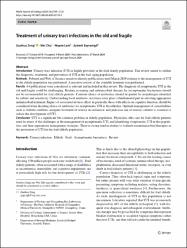| dc.contributor.author | Zeng, Guohua | |
| dc.contributor.author | Zhu, Wei | |
| dc.contributor.author | Lam, Wayne | |
| dc.contributor.author | Bayramgil, Ayberk | |
| dc.date.accessioned | 2020-12-03T07:27:57Z | |
| dc.date.available | 2020-12-03T07:27:57Z | |
| dc.date.issued | 2020 | en_US |
| dc.identifier.citation | Zeng, G., Zhu, W., Lam, W. ve Bayramgil, A. (2020). Treatment of urinary tract infections in the old and fragile. World Journal of Urology, 38(11), 2709-2720. https://dx.doi.org/10.1007/s00345-020-03159-2 | en_US |
| dc.identifier.issn | 0724-4983 | |
| dc.identifier.issn | 1433-8726 | |
| dc.identifier.uri | https://dx.doi.org/10.1007/s00345-020-03159-2 | |
| dc.identifier.uri | https://hdl.handle.net/20.500.12511/6074 | |
| dc.description.abstract | Introduction Urinary tract infection (UTI) is highly prevalent in the frail elderly population. This review aimed to outline the diagnostic, treatment, and prevention of UTI in the frail aging population. Methods Pubmed and Web of Science search to identify publications until March 2019 relating to the management of UTI in the elderly population was performed. A narrative review of the available literature was performed. Results 64 publications were considered as relevant and included in this review. The diagnosis of symptomatic UTI in the old and fragile could be challenging. Routine screening and antimicrobial therapy for asymptomatic bacteriuria should not be recommended for frail elderly patients. Cautious choice of antibiotics should be guided by uropathogen identified by culture and sensitivity. Understanding local antibiotic resistance rates plays a fundamental part in selecting appropriate antimicrobial treatment. Impact of associated adverse effect, in particular those with effects on cognitive function, should be considered when deciding choice of antibiotics for symptomatic UTI in the elderlies. Optimal management of comorbidities such as diabetes mellitus, adequate treatment of urinary incontinence, and judicious use of urinary catheter is essential to reduce the development of UTI. Conclusion UTI is a significant but common problem in elderly population. Physicians who care for frail elderly patients must be aware of the challenges in the management of asymptomatic UTI, and identifying symptomatic UTI in this population, and their appropriate management strategies. There is strong need in studies to evaluate nonantimicrobial therapies in the prevention of UTI for the frail elderly population. | en_US |
| dc.description.sponsorship | National Natural Science Foundation of China (NSFC); National Natural Science Foundation of Guangdong Province | en_US |
| dc.language.iso | eng | en_US |
| dc.publisher | Springer | en_US |
| dc.rights | info:eu-repo/semantics/openAccess | en_US |
| dc.subject | Urinary Infection | en_US |
| dc.subject | Elderly | en_US |
| dc.subject | Frail | en_US |
| dc.subject | Asymptomatic Bacteriuria | en_US |
| dc.subject | Review | en_US |
| dc.title | Treatment of urinary tract infections in the old and fragile | en_US |
| dc.type | review | en_US |
| dc.relation.ispartof | World Journal of Urology | en_US |
| dc.department | İstanbul Medipol Üniversitesi, Tıp Fakültesi, Dahili Tıp Bilimleri Bölümü, İç Hastalıkları Ana Bilim Dalı | en_US |
| dc.authorid | 0000-0003-1782-7808 | en_US |
| dc.identifier.volume | 38 | en_US |
| dc.identifier.issue | 11 | en_US |
| dc.identifier.startpage | 2709 | en_US |
| dc.identifier.endpage | 2720 | en_US |
| dc.relation.publicationcategory | Diğer | en_US |
| dc.identifier.doi | 10.1007/s00345-020-03159-2 | en_US |
| dc.identifier.wosquality | Q1 | en_US |
| dc.identifier.scopusquality | Q1 | en_US |


















